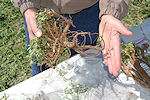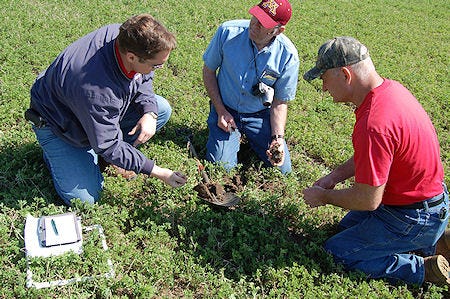
When evaluating an alfalfa stand, look above and below ground.
"Above ground, look for symmetry of growth as plants are emerging," says Paul Peterson, University of Minnesota Extension specialist. "If they have that, they are not injured. If there is no symmetry, there was injury."
Also, count the stems on each plant. For optimum yields, you need a minimum of 55 stems per square foot. If you have 45 to 50 stems, you'll see a yield reduction. And if you count 40 stems or less, you'd be wise to rotate that field with corn.

Where's the tap root? An alfalfa plant may look green on top, but when you dig it up, its root system will tell you more about how healthy it is. This plant has a stunted tap root. Lateral shoots grew to support the plant. Tap roots usually grow down
To help identify root diseases, the Extension specialists brought some specimens with them in zip-locked bags and they dug up some plants in Wilwerding's field. Extension specialist Dean Malvick says
Six diseases
Upper Midwest farmers may see six alfalfa diseases in their alfalfa fields:
crown rot
fusarium wilt
bacterial wilt
phytophthora root rot
brown root rot
aphanomyces root rot
Brown root rot and aphanomyces root rate are fairly new to the region. Both are common in wet, poorly-drained soil, and they are believed to persist in soil for long periods of time.
Aphanomyces root rot in seedlings stunts plants and turns them yellow to purple. The small, tan-colored root system has few nodules. In adult plants, the root system has mostly lateral shoots, no lateral fine fibrous root, and few nodules. Plants do not regrow well after cutting and foliage is often yellow.
A soil test helps determine which race is present. Agronomists suggest planting an alfalfa cultivar resistant to race 2 only after a test confirms that race 2 is present in your soil.

Hands-on check. At a recent U-M training session, (left to right) Mark Rieger with Agassiz Seed, West Fargo, N.D., U-M's Dan Mertens, and Bob Yurczyk, an Avon farmer and certified crop adviser, checked alfalfa stem counts and root health.
There is no variety resistant to brown root rot. The fungus grows slowly and prefers soil temperatures less than 50 degrees F for growth. You might not see brown root rot symptoms until after the crop's third winter. The fungus rots alfalfa roots during the fall and spring, weakening plants and contributing to winterkills. Look for stunted and dead plants in two- and three-year old alfalfa fields and dig them up. Affected plants will have brown sunken lesions on taproots.
"The plant can look healthy, but you need to check the taproot," says Dean Malvick, U of M Extension specialist.
Infected plants may regrow in the spring and then stop growing by early summer because the taproot has rotted.
The brown root rot pathogen lives on corn and soybean residue, but doesn't affect corn or soybeans.
About the Author(s)
You May Also Like






